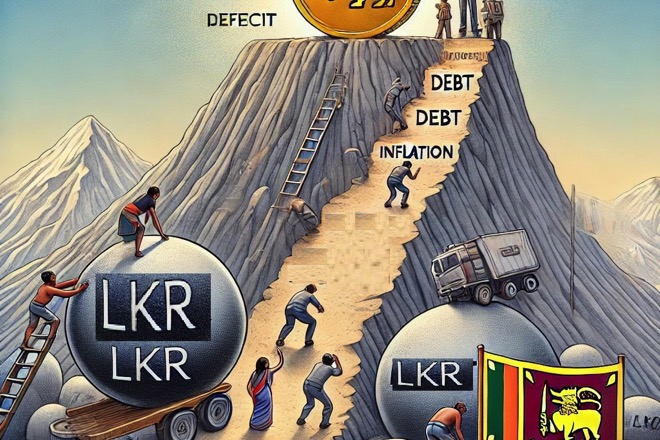By Jithendra Antonio
A Nation at the Crossroads
Sri Lanka’s currency, the Sri Lankan Rupee (LKR), has faced an unrelenting battle over the years, weakening under the weight of global economic shifts, domestic instability, and mounting debt. The rupee’s value, once steady, has plunged to alarming depths, with the exchange rate at over 300 LKR to 1 USD as of mid-2023. In a country deeply affected by inflation, import dependency, and external debt, the prospect of stabilizing the currency seems distant, if not impossible. Yet, amidst the crises, a bold ambition emerges: the vision of making 1 USD equal to 100 LKR.
This ambition is not just an economic pipe dream but a detailed roadmap requiring Sri Lanka to rewire its macroeconomic fundamentals, attract foreign investment, and institute deep structural reforms. To understand how Sri Lanka could turn the tide, we need to delve into a comprehensive analysis of its current situation and a potential path forward.
Inflation Control - The First Pillar of Currency Stability
Inflation is perhaps the most visible enemy of currency strength. In Sri Lanka’s case, inflation spiraled out of control in 2022, soaring to unprecedented levels of 70% at its peak. The government’s efforts to stabilize prices and the rupee through monetary policies have shown some success, with inflation falling to around 12% in 2023. However, for the rupee to appreciate significantly, Sri Lanka must pursue an even more disciplined inflation-targeting regime.
The Central Bank of Sri Lanka (CBSL) must adopt an inflation target of 2-4%, which, while ambitious, is achievable through tight monetary policy and fiscal discipline. By keeping inflation low, the purchasing power of the rupee will increase, reducing the gap between LKR and USD. Key to this will be ensuring that the fiscal deficit is reduced through controlled public spending and better tax collection.
Actionable Insights:
- Introduce stringent inflation-targeting policies, ensuring monetary policy tightens when inflation risks rise.
- Build foreign reserves to shield the LKR from speculative attacks.
Supporting Case Study:
- Sri Lanka’s inflation, which reached 70% in 2022, dropped to around 12% by mid-2023, showing that inflation control is possible with the right measures.
Building Foreign Exchange Reserves - Guarding the Currency
Foreign exchange reserves are the ultimate backstop for any currency. They provide the government with the ammunition to defend the rupee against speculative attacks, while also ensuring that the country can meet its import demands without pressure on the currency.
Sri Lanka’s reserves, however, have been dangerously low. As of mid-2023, reserves were around $3 billion—barely enough to cover two months of imports. For the rupee to strengthen, reserves need to increase significantly. Ideally, the country should aim for reserves that can cover at least 6 months of imports, or around $12 billion.
The roadmap for building reserves lies in boosting exports, tourism, and remittances, as well as attracting foreign direct investment (FDI). Export growth is critical, particularly in higher-value industries like apparel, IT, and agriculture. At the same time, reducing non-essential imports—especially fossil fuels—through domestic production will reduce the strain on reserves.
Actionable Insights:
- Strengthen export sectors with tax breaks and incentivize investment in high-value industries such as electronics, pharmaceuticals, and IT services.
- Attract FDIs in key sectors like renewable energy and logistics by providing tax incentives and streamlining regulatory procedures.
Supporting Case Study:
- As of mid-2023, Sri Lanka’s reserves stand at $3 billion, far below the desired $12 billion for long-term stability. Boosting exports and remittances are critical to expanding reserves.
Export and Import Dynamics - The Balancing Act
For a country’s currency to strengthen, its trade balance must improve. Sri Lanka’s current trade deficit, exacerbated by high import bills and lower export earnings, has been a key factor in the rupee’s weakness. While the country’s exports in 2022 totaled around $13 billion, this figure needs to more than double by 2030 for the rupee to appreciate. In parallel, import reductions—especially of energy and food—are necessary to control the outflow of foreign currency.
Boosting Exports:
To increase export earnings, Sri Lanka must focus on expanding its presence in higher-value industries like IT, logistics, and agriculture. Creating export-friendly policies, such as tax breaks and subsidized loans, would encourage local businesses to venture into global markets. At the same time, the government must incentivize foreign companies to set up export-oriented manufacturing plants in Sri Lanka.
Reducing Imports:
Import substitution is a critical strategy. By investing in renewable energy and modernizing agriculture, Sri Lanka can reduce its dependency on costly energy and food imports. The country currently imports nearly $20 billion worth of goods annually, but localized production in key areas could save billions, reducing the pressure on the currency.
Actionable Insights:
- Introduce policies that encourage export-led growth in high-value industries.
- Develop local industries to reduce reliance on imports, particularly in agriculture and renewable energy.
Supporting Case Study:
- Sri Lanka imports $20 billion annually and reducing this by 10%-15% (identifying non-essential imports and exploring local substitutional products or via promoting local manufacturing via FDIs and JVs) could significantly strengthen the LKR. Expanding exports to $30 billion by 2030 would provide much-needed forex inflows.
Attracting Foreign Direct Investment: Securing Long-Term Forex
FDI is the engine that powers currency appreciation in developing countries. For Sri Lanka to achieve its target of 1 USD = 100 LKR, it must focus on attracting higher levels of FDI in key sectors. Currently, FDI inflows remain modest at around $1 billion annually, far below the potential $3-$5 billion that Sri Lanka could attract if it created an investor-friendly environment.
Key Sectors for FDI:
The government should focus on attracting FDI in sectors such as manufacturing, IT, and renewable energy, which offer long-term growth potential. To do this, Sri Lanka must improve the ease of doing business by cutting through red tape, offering attractive tax incentives, and ensuring political and economic stability.
Actionable Insights:
- Introduce long-term tax incentives and ease regulatory hurdles to attract high-value FDI.
- Develop special economic zones focused on high-tech industries and renewable energy.
Supporting Case Study:
- Sri Lanka’s FDI in 2022 was just $1 billion. Increasing this to $3-$5 billion annually by 2030 will provide a crucial buffer for the rupee.
Debt Restructuring and Sovereign Wealth - Reducing Pressure on the Rupee
A major obstacle to Sri Lanka’s currency stability has been its external debt burden, which stood at approximately $46 billion in 2023. High debt levels have eroded investor confidence and drained foreign reserves, pushing the LKR down. Restructuring this debt—through renegotiations with key creditors such as China, India, and the IMF—will be crucial for long-term currency stability.
Sovereign Wealth Fund (SWF):
To further insulate the rupee from future shocks, Sri Lanka could create a sovereign wealth fund (SWF) from surplus revenues generated by sectors like tourism and exports. The SWF would invest these earnings in foreign assets, providing the country with a steady source of foreign currency returns.
Actionable Insights:
- Pursue debt restructuring negotiations to reduce the external debt burden to $30 billion by 2026.
- Establish an SWF to reinvest earnings from tourism and exports, using them to build a buffer of foreign assets.
Supporting Case Study:
- Sri Lanka’s external debt stood at $46 billion in 2023. Reducing this to $30-$35 billion through restructuring by 2026 is crucial for exchange rate stability.
Tourism and Remittances - The Forex Lifelines
Tourism and remittances have long been key pillars of Sri Lanka’s forex inflows. Pre-pandemic, tourism contributed over $4 billion annually, while remittances added nearly $6 billion. Reinvigorating these sectors is essential to increasing foreign currency reserves and supporting the LKR.
Boosting Tourism:
Sri Lanka’s tourism sector has immense potential to contribute significantly to forex reserves. The country should target high-spending tourists from markets like China, India, and Europe by offering unique experiences such as eco-tourism and wellness tourism.
Increasing Remittances:
Incentivizing expatriates to send remittances through official channels, perhaps by offering higher interest rates on foreign currency accounts, will provide a steady stream of forex inflows.
Actionable Insights:
- Develop high-end tourism packages to attract high-spending tourists.
- Offer incentives to boost remittances, including higher interest rates on foreign currency accounts.
Supporting Case Study:
- Tourism earnings in 2022 were $1 billion, far below the $6 billion target that could be achieved by 2030 with the right policies.
A Vision for a Stronger Rupee
Bringing the exchange rate to 1 USD = 100 LKR is a daunting but achievable goal. It will require a coordinated effort between the government, the Central Bank, and the private sector to implement macroeconomic policies, boost exports, attract FDI, and restructure debt. The road ahead is challenging, but with the right reforms, Sri Lanka can create the conditions for a stable and prosperous economy.
For Sri Lanka, the path to achieving a staggering 1 USD = 100 LKR transcends mere currency valuation; it symbolizes a fierce struggle for economic autonomy. This journey is not simply about numbers on a foreign exchange chart; it reflects the nation's desperate fight against the tides of financial subjugation and political instability that have plagued its history.
As the country grapples with its worst economic crisis since independence in 1948, the implications of this struggle resonate deeply within the fabric of Sri Lankan society. The dramatic depreciation of the rupee is emblematic of broader issues—years of mismanagement, crippling debt, and external shocks that have left the economy in tatters. The once-vibrant nation now finds itself at a crossroads, where each fluctuation in currency value threatens to undermine its sovereignty and self-determination.
This battle is not fought in isolation; it involves complex geopolitical dynamics, particularly with major creditors like China and India. As Sri Lanka seeks to navigate these treacherous waters, the stakes are higher than ever. The quest for a stable exchange rate is intertwined with the need for sustainable economic policies that prioritize local interests over foreign debts. The outcome will not only determine the nation's financial future but also its ability to reclaim its identity and autonomy on the global stage.
Sri Lanka's struggle for a stable currency is a microcosm of its broader fight for economic freedom—a testament to the resilience of its people against the backdrop of an increasingly interconnected world where economic decisions reverberate far beyond national borders.

(The writer is a Consultant specialised in Data Analytics with a Special Focus on Sri Lanka’s Future Direction, and in the fields of Sustainable Energy, ESG, Investments and telecommunications. He can be reached at jithendra.antonio@gmail.com.)

